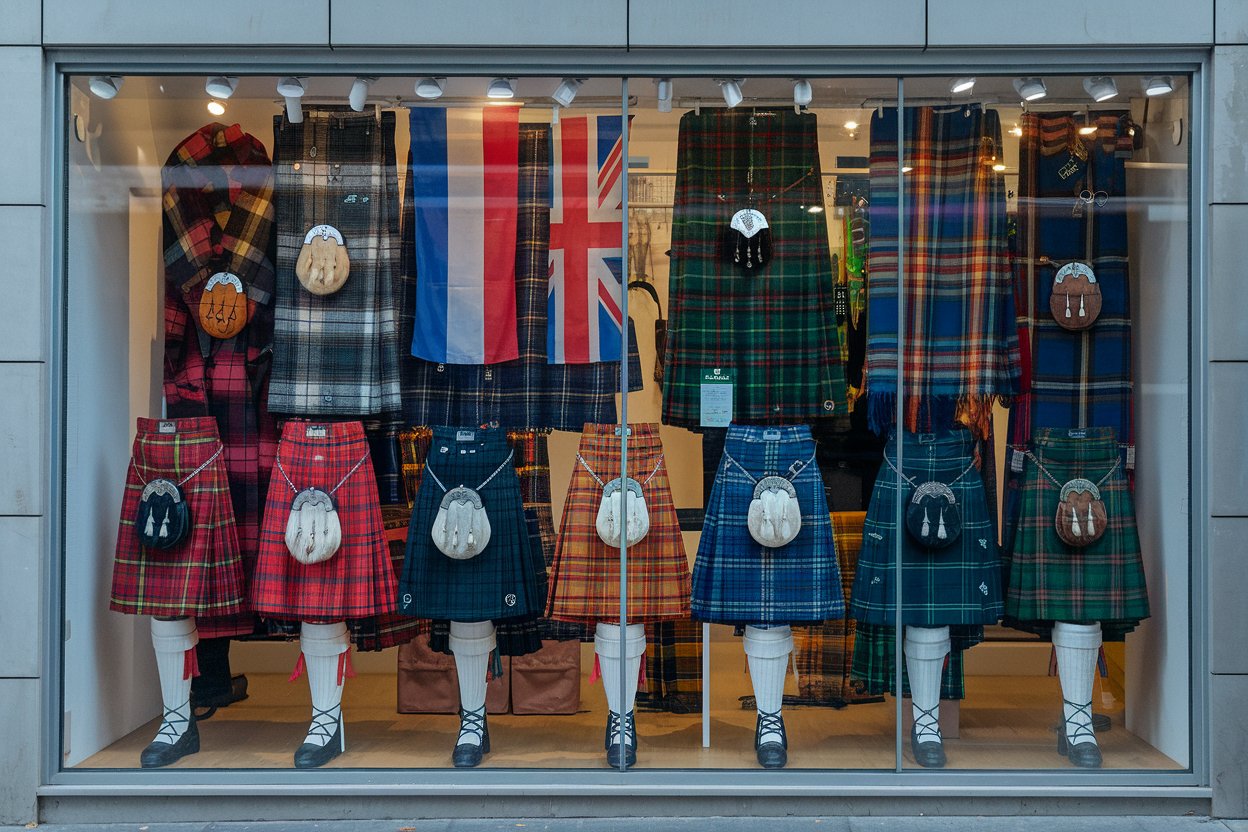
February 18, 2025
How to Order Custom Kilts for Retailers: A Complete Guide (2025 Edition)
The kilt market is undergoing a remarkable transformation as it adapts to shifting consumer preferences, technological advancements, and global fashion influences. For businesses specializing in kilts for retailers, understanding these trends is essential to stay competitive and meet customer demands. From the growing emphasis on sustainability to the rising popularity of kilts beyond Scottish communities, retailers must embrace innovation while honoring tradition. This article explores the key trends shaping the kilt market in 2025, providing valuable insights to help retailers make informed decisions and capitalize on emerging opportunities.
For retailers, this presents a unique opportunity. Offering custom kilts not only caters to niche markets but also appeals to a broader audience looking for personalized and high-quality garments. This guide will provide you with a step-by-step understanding of how to order custom kilts for retail, ensuring you can confidently expand your inventory with this timeless product.
Understanding the Kilts for Retailers
The Kilts for Retailers market has transformed significantly over the years. Traditionally associated with Scotland, kilts are now worn worldwide for various purposes—from formal events to everyday fashion statements.
Key Market Segments
Traditional Kilts
Predominantly worn at formal events like weddings, Highland games, and clan gatherings.
Often crafted from premium wool and feature clan-specific tartan patterns.
Modern Kilts
A fusion of traditional design with contemporary elements.
These kilts attract a younger demographic and are available in materials like cotton, leather, and even denim.
Utility Kilts
Designed for functionality and durability.
Popular with outdoor enthusiasts and tradespeople due to their practical features like extra pockets and adjustable straps.
Understanding these categories helps retailers cater to diverse customer needs while ensuring a well-rounded inventory.
Types of Custom Kilts for Retailers
When considering custom kilts for your retail business, it’s crucial to familiarize yourself with the different types available. Offering a variety of styles can attract a wider customer base.
1. Traditional Kilts
Traditional kilts remain a staple in Scottish culture. These kilts are typically made from 100% wool and feature clan tartans that date back centuries.
Primary Audience: Cultural enthusiasts, event participants, and tourists.
Key Features: Deep pleats, heavy fabric, and classic tartan patterns.
2. Modern Kilts
Modern kilts appeal to those who appreciate cultural attire with a contemporary twist.
Primary Audience: Young adults and fashion-forward individuals.
Key Features: Sleek cuts, various fabrics, and innovative designs.
3. Utility Kilts
Utility kilts prioritize function without compromising style.
Primary Audience: Outdoor workers, festival-goers, and practical dressers.
Key Features: Multiple pockets, durable stitching, and breathable fabrics.
Benefits of Offering Custom Kilts in Retail
Incorporating custom kilts into your retail lineup can provide several advantages.
1. Meeting Market Demand:
The global kilt market has grown beyond cultural events. People from diverse backgrounds are embracing kilts as part of everyday fashion.
2. Personalized Appeal:
Consumers increasingly seek customized clothing that reflects their personality and heritage. Custom kilts cater to this demand by offering personalized tartans, colors, and features.
3. Competitive Edge:
Retailers who offer high-quality, bespoke kilts stand out in a crowded market. Customization options help create a unique selling proposition.
4. Premium Pricing:
Custom, made-to-order kilts often command higher prices, boosting profit margins.
How to Choose a Reliable Kilt Supplier
Partnering with the right supplier is a critical step in ensuring the long-term success of your kilt retail business. The quality of your kilts directly impacts customer satisfaction, brand reputation, and repeat business. Therefore, choosing a supplier who meets high standards is essential. Here’s a more detailed breakdown of the key factors you should consider when selecting a Kilts for Retailers:
1. Reputation: Building Trust Through Experience
A supplier’s reputation speaks volumes about the quality of their products and services.
Online Reviews and Testimonials
Start by researching customer feedback on trusted platforms like Google Reviews, Trustpilot, and industry-specific forums. Look for consistent positive comments about product quality, delivery reliability, and customer service.
Industry Experience
Suppliers with several years of experience in kilt production are often more reliable. They’ve likely refined their processes and built a network of satisfied clients.
Word-of-Mouth Recommendations
Reach out to other retailers within the kilt or fashion industry to get first-hand insights about their supplier experiences.
Tip: Don’t hesitate to ask the supplier for references from other retail clients. Speaking directly to their customers can provide valuable insights into the supplier’s performance.
2. Customization Options: Offering Unique and Personalized Kilts for Retailers
Customization is one of the most attractive aspects of ordering kilts in bulk. Retail customers often seek unique designs that align with their personal or cultural identities.
Tartan Patterns:
Check if the supplier can create custom tartans or replicate specific patterns. This is particularly important for customers who want family or regional tartans.
Material Variety
Ensure the supplier offers various materials, from traditional wool to modern cotton or polyviscose blends. A diverse material selection allows you to cater to both premium and budget-conscious customers.
Accessory Integration:
Some customers prefer kilts that come with matching accessories like sporrans, belts, and kilt pins. Confirm whether your supplier can provide these add-ons.
Tip: Provide clear design specifications, including color samples and measurements, to avoid miscommunication during production.
3. Pricing Transparency: Avoiding Hidden Costs
Understanding the pricing structure helps maintain profitability and build trust with your supplier.
Detailed Quotes
Request an itemized quote that breaks down costs by fabric type, design complexity, customization features, and shipping.
Bulk Discounts
Inquire about discounts for larger orders. Many suppliers offer tiered pricing models where costs decrease as order quantities increase.
Additional Charges
Clarify whether there are any extra fees for rush orders, custom tartans, or packaging.
Tip: Always compare quotes from multiple suppliers to ensure competitive pricing without compromising on quality.
4. Production Capacity: Meeting Demand Efficiently
As your business grows, you’ll need a supplier who can scale with your increasing demand.
Production Volume
Ask how many kilts the supplier can produce within a given timeframe. For large orders, ensure their production line can handle bulk manufacturing without delays.
Lead Times
Discuss production timelines, especially during peak seasons like weddings and Highland games when demand spikes.
Supply Chain Stability
A reliable supplier has a stable network for sourcing raw materials. Disruptions in their supply chain can cause significant delays in your order fulfillment.
Tip: Request periodic updates during the production process to monitor progress and anticipate potential delays.
Final Considerations for Choosing a Supplier
Selecting the right supplier is more than just finding someone who can produce kilts. It’s about establishing a long-term partnership that supports your business growth. Always prioritize quality, reliability, and effective communication when making your decision.
Key Fabrics Used in Kilts for Retailers
| Fabric | Characteristics | Common Uses |
|---|---|---|
| Wool | Warm, breathable, and moisture-wicking. Naturally insulating, making it ideal for colder climates. Traditionally associated with clan tartans. | Formal and historical kilts |
| Cotton | Lightweight, soft, and breathable. Easy to care for and machine washable. Available in a wide range of colors and patterns. | Casual wear, outdoor festivals, and warmer weather. |
| Polyviscose | A blend of polyester and viscose that mimics wool’s appearance. More affordable and less prone to wrinkles. Durable and suitable for everyday wear. | Budget-friendly kilts for events, schools, and tourism markets. |
| Leather | Thick, durable, and stylish with a modern edge. Requires specialized care to maintain texture and quality. Adds a bold, contemporary touch to traditional attire. | Fashion-forward kilts for concerts, events, and alternative wear. |
Trends Shaping the Kilt Market in 2025
Fashion trends evolve with societal values, consumer preferences, and technological advancements. The kilt market, traditionally rooted in Scottish heritage, is now experiencing dynamic changes as it adapts to modern global demands. From eco-conscious materials to global popularity, here’s a closer look at the key trends expected to shape the Kilts for Retailers in 2025
Sustainability: Embracing Eco-Friendly Fabrics
Sustainability has become more than a buzzword; it’s now a crucial factor influencing consumer purchasing decisions across the fashion industry. The kilt market is no exception.
- Eco-Friendly Materials: Manufacturers are increasingly turning to organic cotton, recycled polyester, and sustainable wool sources to meet consumer demands for environmentally responsible products.
- Natural Dyes: Traditional tartan patterns are being produced using natural, non-toxic dyes, reducing the environmental impact while maintaining cultural authenticity.
- Circular Fashion Practices: Retailers are introducing recycling programs where customers can trade in old kilts for discounts on new ones, promoting a more circular economy.
Example: A Scottish kilt manufacturer recently launched a line of kilts made from recycled wool and marketed the collection as “Tradition with a Green Twist,” appealing to eco-conscious consumers worldwide.
Why it matters:
Younger generations, particularly Millennials and Gen Z, are prioritizing brands with strong environmental values. By adopting sustainable practices, kilt retailers can align with this growing demand and secure long-term brand loyalty.
Global Appeal: Kilts Beyond Scottish Borders
Kilts, once predominantly worn within Scottish communities or during cultural events, are now gaining popularity worldwide.
Cultural Crossovers
International fashion designers have incorporated kilts into their runway collections, making them a statement piece in global streetwear and luxury fashion.
Pop Culture Influence
Celebrities and influencers are showcasing kilts at music festivals, on social media, and in everyday street style.
International Markets
Retailers are noticing increased demand from North America, Asia, and even parts of Africa, where kilts are appreciated for their historical significance and stylish appeal.
Example
In Japan, kilts paired with contemporary fashion elements have become popular in urban centers like Tokyo, blending tradition with modern aesthetics.
Why it matters
Expanding marketing efforts beyond Scotland and targeting diverse cultural groups can open new revenue streams for kilt retailers. Language localization, international shipping options, and culturally inclusive advertising can help brands capture these emerging markets.
Frequently Asked Questions (Kilts for Retailers)
Conclusion
Ordering custom kilts for retail involves understanding market demands, choosing reliable suppliers, and prioritizing quality. By following the steps outlined in this guide, you can confidently add custom kilts to your product lineup, meeting customer expectations while maximizing business success.




